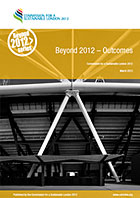The Commission for a Sustainable London 2012 has reviewed LOCOG’s plans for the provision of merchandise bags during the Olympic and Paralympic Games.
Respected international research[1] shows that no single bag solution outperforms other comparable bag solutions against all sustainability criteria. Bags made of highly durable material such as cotton, have significant energy, water and land-take requirements. They often rely on toxic chemicals in the growing process which contributes to their high overall environmental impact.
These environmental impacts must be weighed against the number of uses the bag will receive and in comparison to other bag options. Single use plastic bags, for example, typically have a small carbon footprint but can have worrying downstream impacts on wildlife if they end up in the environment. Bag options must also be reviewed against social and economic criteria, such as whether manufacturing plants are meeting ethical practices like acceptable labour standards.
Ultimately therefore, the focus must always be on reducing the number of bags given out, and to optimise their reuse and recycling after the Games are over.
Our review of the procurement process for bag solutions included the tender requirements for the two-stage tender process; the options submitted at the second stage in the tender process; and, providing advice to LOCOG on issues to consider in the final selection of a preferred option or options.
In our view, LOCOG has carried out a thorough process, incorporating key sustainability criteria to identify a range of appropriate bag options. This process incorporated sustainability criteria in accordance with the LOCOG Sustainable Sourcing Code. We are satisfied that the options which LOCOG considered in its final selection were the best available in the Industry at the time.
However, we strongly encourage LOCOG to pursue a robust integrated approach to the way in which the bags are distributed and the information provided to patrons about options for reuse and recycling.
In our view, LOCOG could charge for bags to send an appropriate signal of restraint in taking a bag with merchandise. A transformative approach would be to designate proceeds from bags sales to catalyse industry research in developing a more sustainable bag system for future events.
We look forward to hearing more from LOCOG about their decision-making on merchandising bags and the way in which they will support minimal bag use through a comprehensive messaging regime.
[1] BSR 2010 Building Long Term Solutions: Retail Shopping Bag Impacts and Options. www.bsr.org
